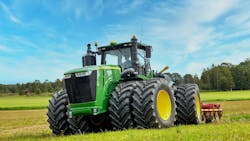Speed and Air Pressure: Understanding the Connection
It’s critical to understand the connection between operational tire speed and air pressure, says Dave Paulk, manager, field technical services, BKT USA Inc.
“At field speeds, five to 10 mph, tires can be run with less air pressure to get a longer and wider footprint to better distribute the weight of the tractor and/or implements,” he says. “This allows for better traction (fuel economy) and less ground-bearing pressure (soil compaction).
“As speeds increase, the load carrying capacity of the tire decreases. The low air pressures that can be used at field speeds are not the same air pressures that should be used at highway speeds. Higher air pressure must be used to carry the load at a faster speed. The higher air pressures create a smaller footprint for lower rolling resistance on the road.”
Paulk says using a load and index chart is helpful to eliminate possibilities of damaging the tire by overloading and underinflation.
“Less air pressure equals less soil compaction in the field. As noted, the air pressures must go up for road transport at higher speeds. Currently, to accomplish this, one must reduce air pressure in the field and inflate the tires before taking the tractor on the road. An air compressor is needed to do this.”
Central tire inflation systems also “are being developed and will be built into the tractor to perform this function,” he notes.
“Air pressures can be reduced in the field and pressures can be increased, as needed, for the road. This can reduce compaction and increase fuel economy in the field and minimize tire failures on the road.
“Running a tire with low air pressures at highway speeds creates heat buildup in the tire. It can’t dissipate the heat quickly enough over long distances and can lead to ply gap turnup and sidewall separations. Standard tires can be used with less air pressure at slower speeds. With the use of increased flexion (IF) and very-high flexion (VF) tires, air pressures can be reduced even more at field speeds.
According to Paulk, a VF tire will carry 40% more weight at the same air pressure as a standard tire of the same size.
“At slower speeds, air pressure can be reduced even more to minimize compaction. As stated, lower air pressures can be used at slower speeds if enough air is used to carry the weight of the tractor and equipment. Proper air pressure for the weight carried, whatever that may be, is required so that the tires are not changing. The load is cyclic.
“For these applications, load bonuses are given at slow speeds (field speeds at five to 10 mph and 10 to 20 mph) for a specified distance.”
Paulk cautions against overloading tires, which “will lead to bead and sidewall failures in the field. An example is sprayers, since at times they run at faster field speeds than tractors and start loaded with liquid. Another example is using a 16-row planter on a three-point hitch. With the planter down at field speed, air pressure can be reduced. When it gets to the end of the row, the planter must be picked up to turn. This is a lot of weight on the tires with low air pressure. Worst case scenarios should be considered when deciding the correct air pressure for the application.
“IF-CFO and VF-CFO tires are used in cyclic applications, such as grain carts and combines. CFO is an abbreviation for cyclic field operation. These applications start with the hoppers or carts empty and build up weight over time. When they are full, they are dumped and start empty again. Because of this, the weight of the machine is constantly 52 are not to be used when considering air pressures for tractors. Tractors generally have a constant weight and are not cyclic.
“Although sprayers may be considered cyclic, they are cyclic in reverse. Sprayers start heavy and full. As they use the liquid in the tanks, they get lighter. Instead of going from light to heavy like combines and grain carts, they go from heavy to light. The faster the speed a tire travels, the less weight carrying capacity it has. The slower the speed, the more weight carrying capacity it has. This is true for all tires.
“When deciding how much air pressure to run, always look at the worst-case scenario and use that to decide,” he says.
